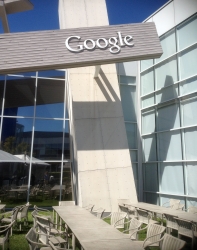eSTEeM
Centre for Scholarship and Innovation
A conference with a difference
20th August 2012
Southern California is where it famously takes 6 people to change a light bulb. One to replace the bulb, and five to share the experience. In August I was invited to an 'Un-conference' at Google's HQ in S. California where the light bulb joke approached near-reality. The invitation-only conference is called SciFoo and is an annual gathering of 300 people whom the organizing committee, consisting of execs from Google, Nature and O'Reilly Media, think it would be cool to invite. Suggestions for who should be invited are sought from previous participants and it was one of these who nominated me. You might think that such an incestuous selection process would merely perpetuate a coterie of silverback males, but though there were some of those (with and without Nobel prizes), there were plenty of younger people, many women (though fewer than 50%) and even some non-scientists. Preparation for the conference was minimal, involving just a wiki where you could describe yourself and suggest topics for discussion, so few participants, most of whom were 'SciFoo Virgins', had any real idea what to expect. Any expectations one might have formed were demolished at the opening session when we were told to forget what was on the wiki because it was going to be ignored.

Frequently recurring keywords were: rebooting, disruptive technologies and neuroscience. Throughout the meeting one of the neuroscientists wore a neoprene swimming cap with electrodes embedded in it and would show you a 3D graphic of his brain on his smartphone, rotated and coloured to pick out the areas of electrical activity. I wanted to ask him whether this 21st century form of navel-gazing wasn't likely to generate howling feedback and a seizure if he stared too long at his own real time brain activity. But, being a mere ecologist, I politely refrained. As the wave of micro-introductions swept along, certain keywords triggered interest. To my surprise, I was not the only participant who claimed affiliation with the Open University. The other was Cory Doctorow, a Canadian writer of science fiction who lives in London and whom I discovered has worked with MCT and is an honorary graduate of the OU. Other professional writers I met included James Gleick (author of Chaos) and SF novelist Stan Robinson.
The conversations were ceaseless and one constantly teetered on the edge of information overload. Even the urinals at Google have eye-level notice boards that enable the user to upload something new in the seconds it takes to download the inevitable result of imbibing ad lib coffee on tap. If these notices are anything to go by, then there are male developers at Google who can parse 20 lines of code in seconds from a standing start. The format of the meeting was a series of discussions timetabled by the participants into 1-hour slots in 8 parallel sessions. If you wanted to talk about something, you stuck a large post-it with the details onto the scheduling grid and anyone interested in attending stuck a coloured dot onto the note. I teamed up with entomologist John Hafernik from San Francisco State University to run a session on public participation in scientific research (aka citizen science). This brought an interesting group of people together including someone from fold.it and the Executive Editor of Scientific American with whom I am now discussing a global media partnership for iSpot. I attended a session called 'Reinventing Education’, given by Emma Brunskill from Carnegie Mellon who described an e-learning infrastructure rather like Social Learn with an Artificial Intelligence tutor that dynamically adapts the curriculum to the learner's needs and progress. Peter Norvig, director of research at Google and one of the two professors who developed the famous Artificial Intelligence course that taught 160,000 students for free, also spoke in this session. This was a stark reminder that everyone is now trying to do what we do and some are re-inventing our model and giving it away.
Perhaps the most memorable session I attended was one I went to entirely by chance. One lunchtime I sat opposite mathematician and sculptor George W. Hart who entertained everyone with topological tricks done with a rubber band. Many of his sculptures are 3D printed because the mathematically-derived shapes can only be made that way. As we all dispersed, he said he was about to run a session on art, maths and biology so I went along. There were a couple of computer animators there, including Scott Snibbe who makes the most amazing wall-sized interactive exhibits that mimic biological processes. He also showed extracts from his work for Bjork's Biophila app. All his work is available on YouTube. Look him up! Drew Berry displayed a beautiful animation of apoptosis (programmed cell death) that used faithfully reproduced molecular structures. Artist Laura Splan showed us work that she has made with her own body. The one session I missed and should have been at? "Imposter Syndrome".
Written and image by Jonathan Silvertown, project leader of iSpot.
News
- The Benefits of Developing a Community of Practice for OU Associate Lecturers 11th March 2024
- Registration now open for the 13th eSTEeM Annual Conference 27th February 2024
- eSTEeM Call for Scholarship Proposals January 2024 22nd January 2024
- The 13th eSTEeM Annual Conference 2024: Call for abstracts now open 5th December 2023
- New eSTEeM projects now up and running 30th November 2023